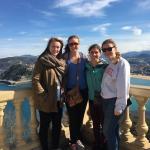Support
While studying abroad in Spain during the spring semester of 2016 I was awarded a travel enrichment grant, thanks to the generous donation of the Weaver Family, to visit Basque Country and Catalonia. These regions are recognized as two of Spain’s historical autonomous communities due to their historical, linguistic, and cultural uniqueness that is distinct from other regions in Spain. As a result, each region has a strong sense of regional identity, which has established a long history of nationalist sentiments and independence movements that have continued into the present day. During my trips to San Sebastián in Basque Country and Barcelona in Catalonia, I observed street art and engaged in conversations with locals through which I gained insights about the identity and nationalist sentiments within each region.
Although I was originally planning to visit Bilbao, a different city in Basque Country, my first host family who had lived in Bilbao for several years, explained that Bilbao is more industrial and multicultural city, while San Sebastián is more quaint and authentic with a stronger sense of regional Basque identity. This was definitely the best decision because I absolutely fell in love with San Sebastián and it is my favorite city in Spain that I have visited! I found an abundance of political stickers, most of which were in the native Basque language, euskera. All throughout the narrow cobble stone streets I came across several stickers and banners that said, “Euskal Preso ETA Iheslariak Etxera,” which I learned means “Bring Basque Prisoners.” As a result of coming across this sticker and conversing with locals I learned about the extreme Basque nationalist “terrorist” group that planned attacks all throughout Spain in the late 80s, which led to the imprisonment and dispersal of accused members all throughout Europe. Although this extreme nationalism has come to a halt in recent years, the dispersal of Basque prisoners continues to remain a heated debate. In addition to investigating this issue I discovered that most Basque citizens identify as both Basque and Spanish and only a mere 20% of the population, mostly in more rural communities, identify solely as Basque.
Along with this investigation of regional identity and nationalist sentiments, I immersed myself in Basque culture by learning about the Basque language as well as the authentic gastronomy. In San Sebastián all street signs and menus etc. are written in euskera first and then Spanish. I found it so fascinating that there is a region in Spanish that speaks a language that is entirely different from Spanish, and is in fact of an unknown origin. Furthermore, Basque Country is renowned for its “pintxos” (pinchos), which are similar to tapas (typical Spanish food) but are smaller and more elaborate. In the bars throughout San Sebastián all of the pintxos are laid out on the bar where guests simply grab a plate and select as many different ones as they’d like! I aimed to try a different pintxo in each bar, especially the ones that were most unique to the region. This was definitely one of my favorite aspects of the trip, quite a culinary experience!
Similar to Basque Country, Catalonia also has its own unique language, Catalan. Although everything is written in Catalan first and then Spanish, Catalan is far more similar to Spanish than euskera, and sounds like a combination of French and Spanish when spoken. While in Barcelona I did not find as many political stickers; however, I did find several banners hanging from balconies that expressed Catalonian pride and support for the independence movement, which has been gaining momentum in recent years. I learned that about 50% of the population identifies solely as Catalan and is in favor of independence while the other 50% is in favor of remaining an autonomous community of Spain and identifies as both Spanish and Catalan. After each trip I compared the sense of regional identity and nationalist sentiments within each region and reached the conclusion that in Basque Country the most pressing issue currently is the situation with the Basque prisoners while in Catalonia there is much more focus on gaining independence.
Along with San Sebastián, Barcelona was very distinct from Madrid and other regions of Spain that I visited. Unlike Madrid, which has predominately Renaissance and Baroque architecture from the 16thand 17th centuries, Barcelona is known for its 20th century Modern architecture, especially the various buildings designed by the famous architect, Atoni Gaudi. This unique architecture creates a vibe within the city distinct from Madrid and serves as a unifying force behind the strong sense of Catalan identity within the city.
During my semester abroad I became fascinated by Spain’s incredible diversity despite its size. I’m so happy to have had the opportunity to travel to each of these two very distinct regions. Through these trips I learned that Spanish culture is not one singular entity, it is an amalgamation and compilation of all of the country’s diverse regions, languages, cuisines, and histories.
